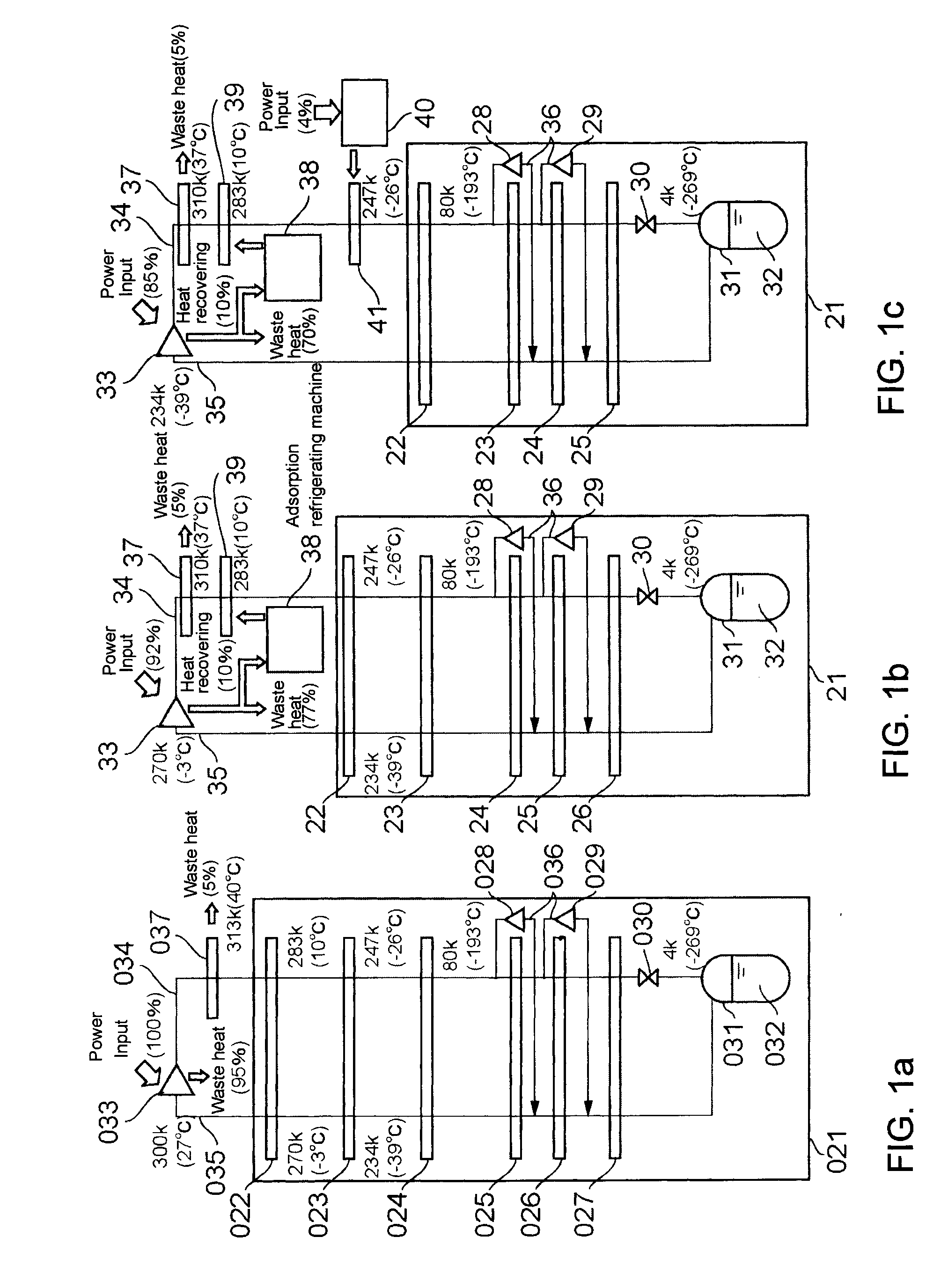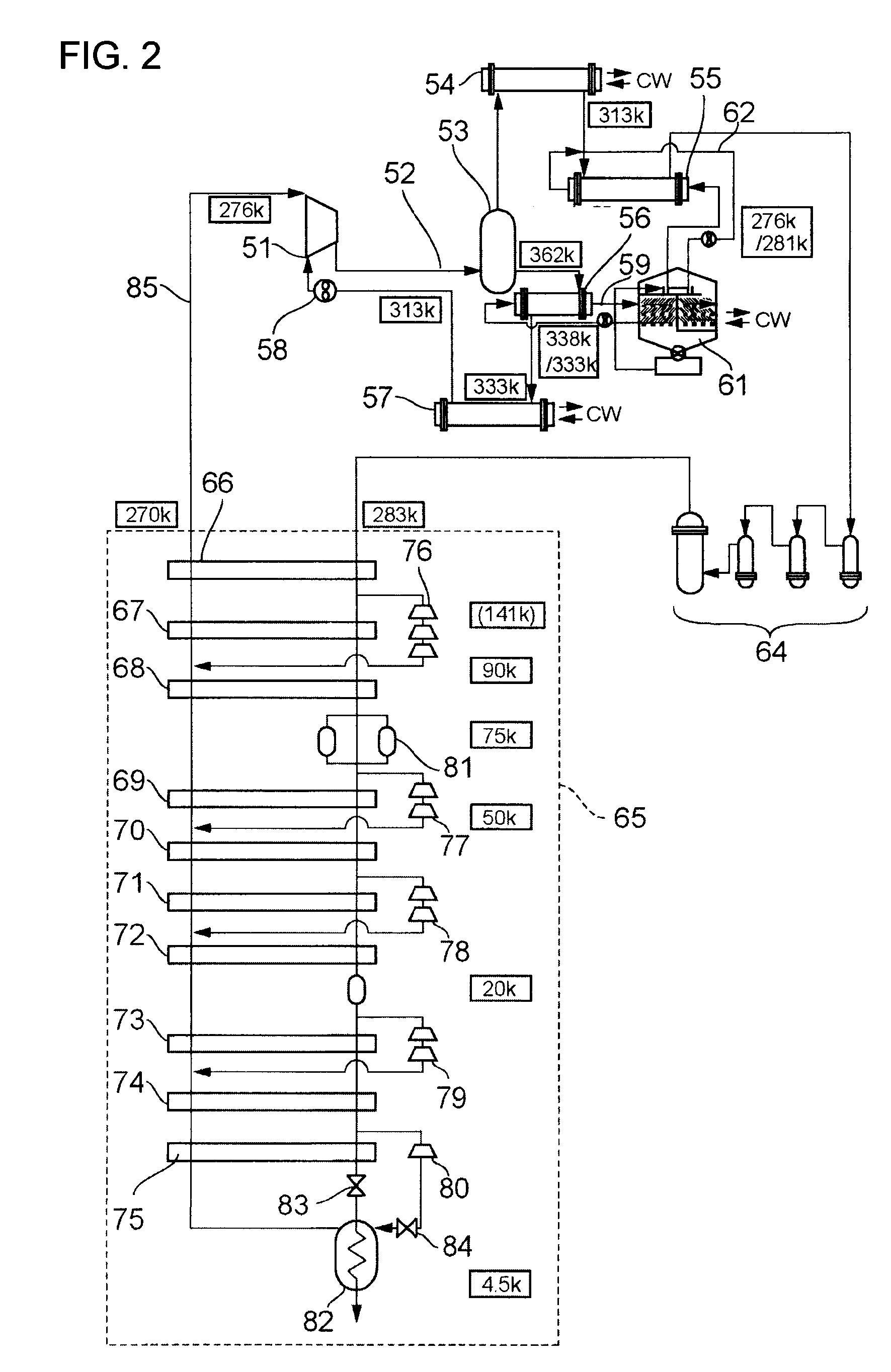Cryogenic liquefying/refrigerating method and system
- Summary
- Abstract
- Description
- Claims
- Application Information
AI Technical Summary
Benefits of technology
Problems solved by technology
Method used
Image
Examples
first embodiment
The First Embodiment
[0052]FIG. 2 is a schematic diagram of the first embodiment of the invention applied to a helium liquefying / refrigerating system. In the drawing, reference numeral 51 is a compressor, in a high pressure line 52 extending from the outlet thereof are provided an oil separator 53, a primary after cooler 54, a second after cooler 55 in this order. Lube oil of the compressor mixed in the high pressure gas discharged from the compressor 51 is separated in the oil separator 53, then the lube oil gives heat to hot water flowing through a hot water line 59 in a heat recovering device 56, then cooled in an oil cooler 57 and returned to the compressor 51 by means of an oil pump 58.
[0053] The high pressure gas got rid of lube oil in the oil separator 53 is cooled in a primary after cooler 54 and a secondary after cooler 55. The hot water heated by the lube oil and flowing in the hot water line 59 is introduced to an adsorption refrigerating machine 61 to be used as a heat s...
second embodiment
The Second Embodiment
[0061] Next, the second embodiment of the system according to the invention will be explained with reference to FIG. 3. The second embodiment is different from the first embodiment shown in FIG. 2 in that a heat exchanger 91 is added in the downstream side of the precision oil separator 64 in the high pressure line 52 and further an ammonia refrigerating machine 92 as a vapor compression refrigerating machine for supplying low temperature refrigerant to the heat exchanger 91 and a branch line 93 are added, other configuration is the same as that of the first embodiment. In FIG. 3, numerical values surrounded by quadrangles indicate temperature at each process.
[0062] In the second embodiment, the high pressure gas which was precooled in the secondary aftercooler 55 and passed through the precision oil separator 64 is further cooled in the heat exchanger 91 by the refrigerant supplied from the ammonia refrigerating machine 92. A portion of the low temperature wat...
third embodiment
The Third Embodiment
[0067] Next, the third embodiment in a case the present invention is applied to a re-liquefying system of natural gas will be explained referring to FIG. 4. In the drawing, reference numeral 101 is a compressor. A primary aftercooler 103 and a secondary aftercooler 104 are provided in this order in a high pressure gas line 102. High pressure gas discharged from the compressor 101 is cooled by these aftercoolers. Reference numeral 105 is a chemical refrigerating machine such as an adsorption refrigerating machine or absorption refrigerating machine, by which cold water is produced utilizing waste heat such as friction loss heat that lube oil received during lubrication of the compressor 101 and retained in the lube oil, in the same way as is by the adsorption refrigerating machine in the first and second embodiment. Said cold water is supplied via a circulation line 106 to the secondary aftercooler 104 as a cold source.
[0068] Reference numeral 107 is a first stag...
PUM
 Login to View More
Login to View More Abstract
Description
Claims
Application Information
 Login to View More
Login to View More - R&D
- Intellectual Property
- Life Sciences
- Materials
- Tech Scout
- Unparalleled Data Quality
- Higher Quality Content
- 60% Fewer Hallucinations
Browse by: Latest US Patents, China's latest patents, Technical Efficacy Thesaurus, Application Domain, Technology Topic, Popular Technical Reports.
© 2025 PatSnap. All rights reserved.Legal|Privacy policy|Modern Slavery Act Transparency Statement|Sitemap|About US| Contact US: help@patsnap.com



